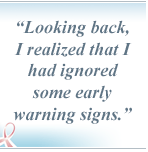"I Wasn't Too Young to Get DVT"
Until this year, I thought health problems like DVT and pulmonary embolism were things I wouldn't have to think about until much later in life. I had no idea how common DVT was, and that it strikes people of all ages – even 35-year-olds like me. It was only after I had been hospitalized with DVT and my doctor asked if I had seen Melanie Bloom on Larry King Live that I discovered the Coalition to Prevent DVT Web site and learned the facts.
A timely discovery
When I visited the site, my first thought was how ironic it was that I had been hospitalized with DVT during DVT Awareness Month! I went on to explore further, reading the white paper on DVT and printing out the DVT Risk Assessment Tool to give to my friends and family.
When I saw the DVT statistics, I began to cry, overwhelmed by how many lives this condition takes and thankful that mine had been spared. I knew I had to share my story, to help others recognize the symptoms of DVT and get help in time.

Strain or pain?
My husband and I kicked off 2006 with a New Year's resolution to start working out regularly. We hired a personal trainer to help us reach our fitness goals. Soon after we started our new routine, I began feeling pain in my upper abdominal area, just under my left breast. I thought I had pulled a muscle and didn't worry about it.
But six weeks later the pain was still there. I also felt short of breath whenever I climbed stairs or walked any distance. I chalked it up to working out at a tougher pace. Each day I thought the pain would get better, but it kept getting worse. I was too uncomfortable to sleep lying flat, so I used six pillows to prop myself up in bed. My legs started feeling heavy, and I felt kind of funny overall.
The crisis point
Then, one evening in late February, I couldn't ignore my symptoms anymore. When I went upstairs to bed, my legs were hurting so much and moving so slowly I could hardly make the climb. By the time I reached the top of the stairs, I was panting, my heart was racing and I was sweating profusely. A few minutes later, I blacked out. My husband heard the thump and ran upstairs to find me lying on the floor.
I put off getting help until the next morning, when I went to a 24-hour emergency center. A chest X ray revealed a spot on my lung that the doctor suspected was a blood clot. He called an ambulance to take me to the hospital, where a CAT scan showed I had clots in both lungs. The doctors put me on blood-thinning medication and kept me in the hospital for five days. During my stay I was examined by a series of specialists and had ultrasounds performed on my legs and my heart. When I was discharged I received a prescription for another blood thinner, which I may have to take for an indefinite length of time.
Risks overlooked
DVT took me by surprise because of my age and overall good health. I didn't smoke or drink, had no serious ailments and came from a family that enjoyed great longevity. But when I researched DVT, I found out that I had a couple of major risk factors: I had taken birth control pills for 17 years, and I travel frequently on business, including flying to California four or five times a year. In fact, I had made two back-to-back trips there a couple of months before I was hospitalized.
Looking back, I also realized that I had ignored some early warning signs of DVT. Last fall I had pain that started in one calf and then moved behind the knee, and I felt as if the blood wasn't moving through my legs properly. It crossed my mind that I might have a blood clot, but as soon as the pain went away, I dismissed that possibility. I thought I was too young for a problem like that.
Opening people's eyes
Since learning the facts, I've discussed DVT in great detail with about 30 people, including a 39-year-old colleague who often drives for eight hours at a time. He told me he had a persistent pain in his leg. After I told him my story, he went to the Coalition's Web site to learn more; I urged him to also see his doctor. I told him what I tell everyone, no matter how young and healthy they seem to be: Listen to your body, and if you have any symptoms of DVT, don't wait to get help. I know I wouldn't, if I had to do it over again.